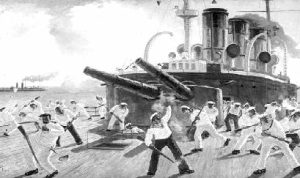
Mutiny on the Potemkin
Building a Base in the Military: Key to Communist Revolution
“The Bolsheviks were able to assume power due to the special effort which the party devoted to winning the support of military troops in the rear and in the front. Only the Bolsheviks perceived the necessary crucial significance of the armed forces in the struggle for power.” —The Bolsheviks Come to Power, Alexander Rabinowitch
October 25—Western media predict that Putin’s draft will lead to the collapse of Russia’s military campaign in Ukraine. If NATO propaganda is to be believed, draft-dodgers may even sink the Russian government.
The tactic of draft resistance will never lead to revolution or the ending of imperialist war. It certainly is not the strategy that can lead us to communist revolution. That requires, as the Bolsheviks learned, communist organizing inside the military.
Resistance and other forms of avoiding military service reached massive proportions in the US during the Vietnam War. It didn’t stop U.S. imperialism. The Vietnamese armed struggle did that.
By then, nearly half the US troops had engaged “in organized resistance or outright rebellion” according to the Pentagon. US Army Chief of Staff General Westmoreland, the former US commander in Vietnam, argued in secret White House meetings to end the war before “we lose the army.”
The US retreated to an air war before being forced to withdraw from Vietnam. The level of communist organizing in the US military never approached what was required to make a revolution. Still, lessons learned during the intense struggle in the US Armed Forces remain invaluable.
Soldiers and sailors have revolted many times against capitalist regimes around the world. Our goal is to turn revolt into communist revolution. Nothing less will free us from the deadly chains of capitalism.
The First Revolt of the Black Sea Fleet
The Bolsheviks’ “special effort” to win the support of the military troops started almost twenty years before their 1917 revolution, even before the formation of the Bolshevik Party.
In 1904, the Tsar declared war on Japan, in part to quell revolutionary fervor among Russian workers and peasants. The revolutionary movement grew among the Army and Navy regiments which had the most contact with the revolutionary propaganda and agitation that was sweeping the country.
The most significant revolt occurred a year later, on the battleship Potemkin. The Bolshevik torpedo quartermaster, Afansy Mantushenko, was a courageous leader of that mutiny. He described it as “one of the object lessons of the revolutionary struggle in which the broad masses of workers and particularly the sailors and soldiers learned the lesson of revolutionary struggle and the concrete tactics of armed revolt.”
When the mutiny began, Captain Golikov ordered Mantushenko to drop his weapon. “I will drop my weapon when I am no longer a living being but a corpse,” Mantushenko replied. “Get off the ship! This is the peoples’ ship and not yours.”
The arrogant Captain refused. The sailors threw his corpse overboard.
The rebellion spread to other ships in the Black Sea Fleet and the city of Odessa. To halt the growing unity between Odessa workers and Black See Fleet sailors, the police started an anti-Jewish pogrom. The port was set on fire. Over two thousand people died in the overnight battle.
The Bolsheviks were not ready for armed insurrection. They did not even set up a center to lead the military work.
The left coalition in Odessa took the initiative to direct activity from the shore. A crucial mistake was to free the Navy officers for humanitarian reasons. During two days of debate, the freed officers helped organize bourgeois conciliators to infiltrate these meetings, derailing revolutionary activity.
Key Bolshevik leaders were in exile during this period. The party sent some cadre to Odessa to bolster the party presence there and in the Black Sea fleet. By the time they arrived, the tide had turned against the rebels.
The Lessons of the Potemkin Mutiny
The Bolsheviks recognized the tremendous significance of the Potemkin mutiny and the mass support in Odessa. For the first time, a large part of the tsarist military forces came over to the side of revolution.
The party formed detachments of the revolutionary army among the troops. It learned that these detachments must give military leadership to the masses, form base points for wider open struggle, and develop the creative efforts of the rank-and-file workers, soldiers, and sailors.
The Potemkin rebellion was the first step in converting the Russian revolution into an international force, bringing it face to face with Europe. Fraternization with “enemy” rank-and-file soldiers emerged as a political/military weapon.
A revolutionary army is necessary because Great historical conflicts can only be settled by force. That requires a revolutionary army. Building a base in the military was then, and is now, the necessary strategy for communist revolution.
In Part 2: How the Russian communists learned from and built on of the Potemkin rebellion, leading to their 1917 Socialist revolution and the rejection of pacifism by the international communist movement.
Read our pamphlet:
“Soldiers, Sailors, Marines: Crucial to a Communist Workers’ Revolution” here

